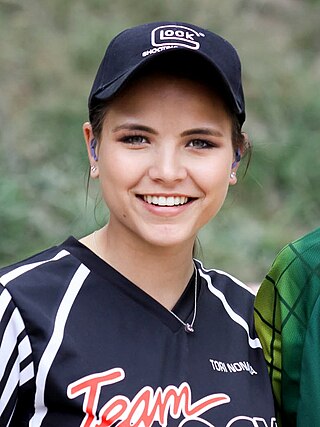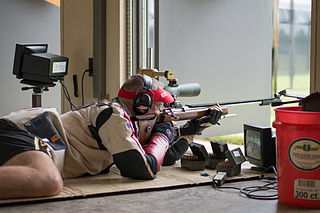
Shooting sports is a group of competitive and recreational sporting activities involving proficiency tests of accuracy, precision and speed in shooting — the art of using ranged weapons, mainly small arms and bows/crossbows.

In the United States (U.S.), a marksmanship badge is a U.S. military badge or a civilian badge which is awarded to personnel upon successful completion of a weapons qualification course or high achievement in an official marksmanship competition. The U.S. Army and the U.S. Marine Corps are the only military services that award marksmanship qualification badges. However, marksmanship medals and/or marksmanship ribbons are awarded by the U.S. Navy, U.S. Coast Guard, and U.S. Air Force for weapons qualifications. For non-military personnel, different U.S. law enforcement organizations and the National Rifle Association (NRA) award marksmanship qualification badges to those involved in law enforcement. Additionally, the Civilian Marksmanship Program (CMP) and the NRA award marksmanship qualification badges to U.S. civilians. Most of these organizations and the U.S. National Guard award marksmanship competition badges to the people they support who succeed in official competitions.

Practical shooting, also known as dynamic shooting or action shooting, is a set of shooting sports in which the competitors try to unite the three principles of precision, power, and speed, by using a firearm of a certain minimum power factor to score as many points as possible during the shortest time. While scoring systems vary between organizations, each measures the time in which the course is completed, with penalties for inaccurate shooting. The courses are called "stages", and are shot individually by the shooters. Usually the shooter must move and shoot from several positions, fire under or over obstacles and in other unfamiliar positions. There are no standard exercises or set arrangement of the targets, and the courses are often designed so that the shooter must be inventive, and therefore the solutions of exercises sometimes vary between shooters.
Springfield Armory, Inc., is an American commercial firearms manufacturer and importer based in Geneseo, Illinois. Founded in 1974 by Bob Reese and family, the company produces rifles such as the M1A and imports handguns such as the XD series and Hellcat. The company is unrelated to the like-named former manufacturer of US military firearms in Massachusetts, Springfield Armory.

Metallic silhouette shooting is a group of target shooting disciplines that involves shooting at steel targets representing game animals at varying distances, seeking to knock the metal target over. Metallic silhouette is shot with large bore rifles fired freehand without support out to 500 meters, and with large bore handguns from the prone position with only body support out to 200 meters. Competitions are also held with airguns and black-powder firearms. A related genre is shot with bow and arrow, the metal targets being replaced with cardboard or foam. The targets used are rams, turkeys, pigs, and chickens, which are cut to different scales and set at certain distances from the shooter depending on the specific discipline.

The International Practical Shooting Confederation (IPSC) is the world's largest shooting sport association, and the largest and oldest within practical shooting. Founded in 1976, the IPSC nowadays affiliates over 100 regions from Africa, Americas, Asia, Europe, the Middle East, and Oceania. Competitions are held with pistol, revolver, rifle, and shotgun, and the competitors are divided into different divisions based on firearm and equipment features. While everyone in a division competes in the Overall category, there are also separate awards for the categories Lady, Super Junior, Junior, Senior, and Super Senior.

NRA Precision Pistol, formerly known as NRA Conventional Pistol, is a national bullseye shooting discipline organized in the United States by the National Rifle Association of America. Emphasis is on accuracy and precision, and participants shoot handguns at paper targets at fixed distances and time limits. Other organizations in the United States and Canada have established rules and keep records of similar disciplines, including the Civilian Marksmanship Program (CMP) in the United States.

A racegun or race gun is a firearm that has been modified for accuracy, speed, and reliability. Often a semi-automatic pistol, raceguns are used primarily in practical shooting competitions and are modified to function best within a certain set of rules, such as weight, size, and capacity requirements.

The United States Practical Shooting Association(USPSA) is the national governing body of practical shooting in the United States under the International Practical Shooting Confederation (IPSC). Its over 35,000 active members and over 500 affiliated clubs make USPSA the largest practical shooting organization in the United States and the second largest region within IPSC after the Russian Federation of Practical Shooting. USPSA publishes a monthly member magazine called Front Sight.

Power Factor (PF) in practical shooting competitions refers to a ranking system used to reward cartridges with more recoil. Power factor is a measure of the momentum of the bullet, which to some degree reflects the recoil impulse from the firearm onto the shooter.

High Power Rifle, also called XTC from "Across the Course", is a shooting sport using fullbore target rifles which is arranged in the United States by the National Rifle Association of America (NRA). The sport is divided into classes by equipment, and popular types of matches include Service Rifle, Open, Axis and Allies and metallic silhouette. The term High Power Rifle sometimes also includes the international shooting disciplines of Palma and F-Class by the International Confederation of Fullbore Rifle Associations (ICFRA) which are represented by the NRA in the United States.

Tori M. Nonaka is an American sport shooter with two IPSC Handgun World Shoot silver medals in the Standard division Lady category. She was one of three members of Team GLOCK. She grew up in Woodbridge, Virginia, where she began shooting at age 3. At age 12, Tori attended the US Shooting Academy, which sparked her interest in becoming a professional shooter and led her to begin shooting competitively. On March 2, 2011, GLOCK, Inc announced that 15-year-old Tori would be a member of Team GLOCK Shooting Squad. In March 2017 Tori went independent and left Team Glock. She was replaced by Ashley Rheuark.
Shooting sports in Canada are practised across the country at recreational and competitive levels, including internationally and at the Olympics. Each province has its own organizations that govern the various disciplines. Many of the disciplines are connected nationally and some are part of larger international organizations.

Dynamic Sports Shooting Norway (DSSN), NorwegianDynamisk Sportsskyting Norge (DSSN), is the Norwegian association for practical shooting under the International Practical Shooting Confederation. It was constituted in 1979 as Norges Forbund for Praktisk Skyting (NFPS), and changed its name to Dynamisk Sportsskyting Norge in 2013.

The IPSC Handgun World Shoot is the highest level handgun match within the International Practical Shooting Confederation (IPSC) which consists of several days and at least 30 separate courses of fire. The Handgun World Shoots are held triennially on a rotational cycle with the other two main IPSC disciplines Rifle and Shotgun.

Multigun, Multi Gun or Multi-Gun, often also called 2-Gun or 3-Gun depending on the types of firearms used, are practical shooting events where each of the stages require the competitor to use a combination of handguns, rifles, and/or shotguns Multigun has a lot in common with ordinary IPSC/ USPSA single gun matches, and matches generally have courses of fire where the shooter must move through different stages and engage targets in a variety of different positions.
Benjamin Thomas Stoeger is an American competition shooter and firearms instructor who started competing actively in 2005. He placed first in the 2017 IPSC Handgun World Shoot, second behind Bob Vogel in the 2011 IPSC Handgun World Shoot, and placed third in the 2014 IPSC Handgun World Shoot behind Eric Grauffel and Simon "JJ" Racaza. He is also three time IPSC US Handgun Production Champion, eight time USPSA Handgun Production Champion.

Daniel Horner is an American sport shooter and firearms instructor who placed fourth in the Production division at the 2008 IPSC Handgun World Shoot. He shoots varied action shooting competitions with an emphasis on multigun, and is a 10-time USPSA Multigun Champion in the Tactical division. Horner competed for the U.S. Army Marksmanship Unit from 2005 to 2018, when he joined Team SIG Sauer.

Bullseye shooting is a category of shooting sport disciplines where the objective is to score points with carefully placed precision fire by hitting a target as close to its center as possible. The name refers to the target center's nickname, the "bull's eye". In Scandinavia, this type of shooting competition is referred to as Range-Shooting, as it usually takes place at dedicated shooting range.

The French Shooting Federation (FFTir), FrenchFédération Française de Tir, is the umbrella organization for sport shooting in France. It was founded in its current form in 1967, but has roots as far back as 1866.




















